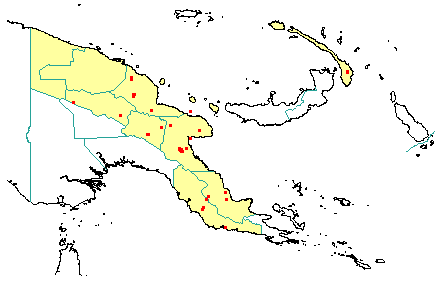
in PNGplants database
PNGTreesKey – Gastonia spectabilis (Harms) Philipson |
Barry Conn (NSW) & Kipiro Damas (LAE).
Guide to trees of Papua New Guinea
Copyright held by the authors, National Herbarium of New South Wales, and Papua New Guinea National Herbarium
Blumea Vol. 68: 494 (1970)
Other Literature: W.R. Philipson, Handbooks of the Flora of Papua New Guinea 10 (1995) Fig. 2.
Family: Araliaceae
Dicotyledon
Timber Group: Occasional timber species
Field Characters: Large canopy tree or Small sub-canopy tree (20-34 m high); Bole cylindrical (50-100 cm diam.); straight (bole 15-20 m long); buttresses buttresses absent; spines spines absent; aerial roots aerial roots absent; stilt roots stilt roots absent; Bark grey or brown, rough, slightly scaly or flaky; Subrhytidome (under-bark) brown; less than 25 mm thick, 12.0-18.0; bark blaze consisting of one layer; faintly to non-aromatic; onion-like (celery-like aroma); outer blaze white or pale yellow, with stripes, fibrous; inner blaze white or pale yellow, with stripes, fibrous; bark exudate (sap) present, colourless, not readily flowing (spotty), colour not changing on exposure to air, sticky; terminal buds not enclosed by leaves.
Indumentum: Complex hairs absent; stinging hairs absent; mature twig indumentum (hairs) absent.
Leaves: Leaves clustered at end of branches, spiral (leaves occurring singly at a node and arranged spirally up the branchlet), compound (a leaf made up from two or more leaflets); petiole present, not winged, attached to base of leaf blade, swollen (at point of attachment to branchlet and at node of first leaflets); leaves pinnate (unbranched with more than three leaflets); petiolule not swollen (but attached to swollen nodes); rachis present, absent, absent; leaves with a terminal leaflet (the number of leaflets odd - imparipinnate), broadest below middle, 7.0-14.0 cm, 4.0-6.5 cm, leaflets opposite, symmetric, terminal developing leaflet buds straight; venation pinnate, secondary veins open, prominent, intramarginal veins absent; leaves lower surface pale green, upper surface dull green, indumentum (hairs) absent; absent; domatia absent; stipules absent.
Flowers: Inflorescence terminal, flowers on a branched axis (arising from a single point (whorl), cones absent; flowers bisexual, stalked, flowers with many planes of symmetry, 10.0-15.0 mm long, diameter large (more than10 mm diam.) (12-15 mm diam.); perianth present, with distinct sepals and petals whorls, inner perianth pale green; 4, free; stamens 100, present, free of each other, free of the perianth; ovary inferior, carpels joined (when more than one), locules (10-) 16-22; styles solitary (partly joined to form a stylopodium of appressed styles), (10-) 16-22.
Fruits: Infrutescence arranged on branched axis (arising from a single point (whorl), fruit 7.0-9.0 mm long, 10.0 (c.) mm diam., black, not spiny, non-fleshy, simple, indehiscent, drupe; seeds 20 (c.), to about 5 mm long (c. 6 mm long), not winged, narrow (longer than wide), seed 1-10 mm diam. (3-4 mm diam.).
Distribution: West Sepik, East Sepik, Madang, Morobe, Western Highlands, Eastern Highlands, Central, Northern & New Ireland.
 | Botanical records in PNGplants database |